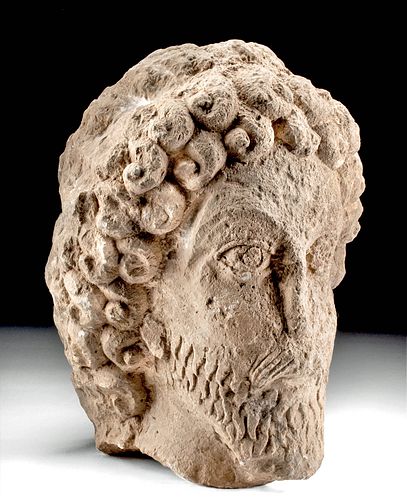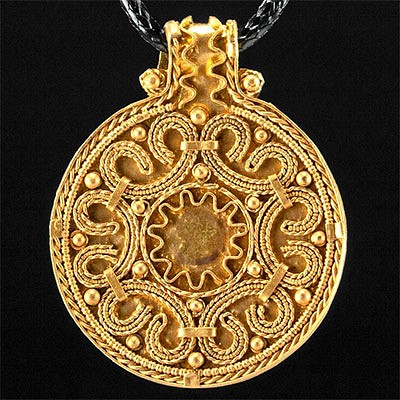Published / Exhibited Parthian Limestone Head
Lot 100
About Seller
Artemis Gallery
686 S Taylor Ave, Ste 106
Louisville, CO 80027
United States
Selling antiquities, ancient and ethnographic art online since 1993, Artemis Gallery specializes in Classical Antiquities (Egyptian, Greek, Roman, Near Eastern), Asian, Pre-Columbian, African / Tribal / Oceanographic art. Our extensive inventory includes pottery, stone, metal, wood, glass and textil...Read more
Estimate:
$11,000 - $19,500
Absentee vs Live bid
Two ways to bid:
- Leave a max absentee bid and the platform will bid on your behalf up to your maximum bid during the live auction.
- Bid live during the auction and your bids will be submitted real-time to the auctioneer.
Bid Increments
| Price | Bid Increment |
|---|---|
| $0 | $25 |
| $300 | $50 |
| $1,000 | $100 |
| $2,000 | $250 |
| $5,000 | $500 |
| $10,000 | $1,000 |
| $20,000 | $2,500 |
| $50,000 | $5,000 |
| $100,000 | $10,000 |
| $200,000 | $20,000 |
About Auction
By Artemis Gallery
Aug 19, 2021
Set Reminder
2021-08-19 10:00:00
2021-08-19 10:00:00
America/New_York
Bidsquare
Bidsquare : Ancient & Ethnographic Art Through The Ages
https://www.bidsquare.com/auctions/artemis-gallery/ancient-ethnographic-art-through-the-ages-7345
Ancient art from Egypt, Greece, Italy and the Near East, as well as Asian, Fossils, Pre-Columbian, Native American, African / Tribal / Oceanic, Fine art, and much more! All categories, all price ranges... all legally acquired and guaranteed to be as described or your money back. Artemis Gallery info@artemisgallery.com
Ancient art from Egypt, Greece, Italy and the Near East, as well as Asian, Fossils, Pre-Columbian, Native American, African / Tribal / Oceanic, Fine art, and much more! All categories, all price ranges... all legally acquired and guaranteed to be as described or your money back. Artemis Gallery info@artemisgallery.com
- Lot Description
Ancient Near East, Parthia, ca. 200 to 100 BCE. A finely carved limestone funerary head, possibly portraying a Parthian king from Dura Europos. The head is quite large and well executed with a quixotic visage comprised of mesmerizing almond-shaped eyes - both with delineated lids, irises, and pupils, arched brows leading to a straight nose between them, a well-manicured mustache and wavy beard framing his lips, and a full head of hair with skillfully carved curls rendered in the Parthian style as seen on coins and other sculptures of the period. Size: 10.125" L x 11.125" W x 15.5" H (25.7 cm x 28.3 cm x 39.4 cm)
Published and Exhibited: Seven Millennia of Persian Pottery: Catalogue of the Gluck Collection at Tekisui Museum, Ashiya, Japan, April 1-July 16, 1978, #169.
Provenance: private Los Angeles, California, USA collection; ex-Malter Galleries Auction 80, The Jay Gluck Collection, April 7, 2002, lot 100. Published and Exhibited: Seven Millennia of Persian Pottery: Catalogue of the Gluck Collection at Tekisui Museum, Ashiya, Japan, April 1-July 16, 1978, #169.
All items legal to buy/sell under U.S. Statute covering cultural patrimony Code 2600, CHAPTER 14, and are guaranteed to be as described or your money back.
A Certificate of Authenticity will accompany all winning bids.
PLEASE NOTE: Due to recent increases of shipments being seized by Australian & German customs (even for items with pre-UNESCO provenance), we will no longer ship most antiquities and ancient Chinese art to Australia & Germany. For categories of items that are acceptable to ship to Australia or Germany, please contact us directly or work with your local customs brokerage firm.
Display stands not described as included/custom in the item description are for photography purposes only and will not be included with the item upon shipping.
#159537Head is a fragment from a larger statue. The back of the head is uncarved. Chips/losses to high-pointed areas and peripheries such as beard, curls, browline, nose, and neckline. Traces of white pigmentation suggest it was once painted. Scattered deposits.Condition
- Shipping Info
-
All shipping is handled in-house for your convenience. Your invoice from Artemis Gallery will include shipping calculation instructions. If in doubt, please inquire BEFORE bidding for estimated shipping costs for individual items.
-
- Buyer's Premium



 EUR
EUR CAD
CAD AUD
AUD GBP
GBP MXN
MXN HKD
HKD CNY
CNY MYR
MYR SEK
SEK SGD
SGD CHF
CHF THB
THB















